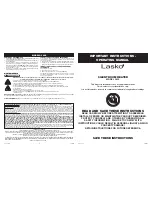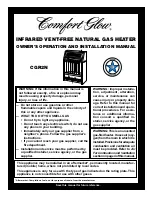
30
MaIntenance
General
Water heater maintenance includes inspection and testing of the
Temperature Pressure Relief valve, periodic tank flushing and
cleaning, and removal of lime scale from the heating elements. Where
used, water heating system circulating pumps should be oiled.
Tank flushing and circulating pump lubrication should be performed in
accordance with the maintenance schedule, see Table 7. Tank sediment
removal and element lime scale removal must be performed when
needed as determined by periodic inspections.
teMperature-pressure relIef ValVe operatIon
DANGER
•
Burn hazard.
•
Hot water discharge.
•
Keep clear of Temperature
Pressure Relief Valve
discharge outlet.
It is recommended that the Temperature-Pressure Relief valve should
be checked to ensure that it is in operating condition every 6 months.
When checking the Temperature-Pressure Relief valve operation,
make sure that (1) no one is in front of or around the outlet of the
Temperature-Pressure Relief valve discharge line, and (2) that the
water discharge will not cause any property damage, as water may be
extremely hot. Use care when operating valve as valve may be hot.
To check the relief valve, lift the lever at the end of the Temperature-
Pressure Relief valve several times, see Figure 6. The valve should
seat properly and operate freely.
If after manually operating the valve, it fails to completely reset and
continues to release water, immediately close the cold water inlet to
the water heater and drain the water heater, see Draining And Flushing
on page 15. Replace the Temperature-Pressure Relief valve with a
properly rated/sized new one, see Temperature-Pressure Relief valve
on page 8 for instructions on replacement.
fIGure 6.
If the Temperature-Pressure Relief valve on the water heater weeps or
discharges periodically, this may be due to thermal expansion.
note:
Excessive water pressure is the most common cause of
Temperature-Pressure Relief valve leakage. Excessive water system
pressure is most often caused by “thermal expansion” in a “closed
system.” See Closed Water Systems and Thermal Expansion on
page 9. The Temperature-Pressure Relief valve is not intended for the
constant relief of thermal expansion.
Temperature-Pressure Relief valve leakage due to pressure build up in
a closed system that does not have a thermal expansion tank installed
is not covered under the limited warranty. Thermal expansion tanks
must be installed on all closed water systems.
do not pluG the teMperature-pressure relIef ValVe
openInG. thIs can cause property daMaGe, serIous
Injury or death.
Explosion Hazard
Temperature-Pressure Relief Valve
must comply with ANSI Z21.22-
CSA 4.4 and ASME code.
Properly sized Temperature-Relief
Valve must be installed in opening
provided.
Can result in overheating and
excessive tank pressure.
Can cause serious injury or death.
Component
Operation
Interval
Required
Tank
Flushing
Monthly
Sediment
Removal
As Needed
Elements
Lime Scale
Removal
As Needed
UN-LIME
delimer and
element gaskets
taBle 7. MaIntenance schedule.
flushInG
To flush the water heater:
1. Turn off the electrical supply to the water heater at the breaker or
disconnect switch.
2. Turn off the pilot toggle switch on the water heater.
3. Ensure the cold water inlet valve is open.
4. Open a nearby hot water faucet and let the water run until the
water is no longer hot. Then close the hot water faucet.
5. Connect a hose to the water heater drain valve and terminate it
to an adequate drain.
6. Ensure the drain hose is secured before and during the entire
flushing procedure. Flushing is performed with system water
pressure applied to the water heater.
7. Open the water heater drain valve to flush.
8. Flush the water heater to remove sediment and allow the water
to flow until it runs clean.
9. Close the water heater drain valve when flushing is completed.
10. Remove the drain hose.
11. Fill the water heater – see the Filling The Water Heater section
in this manual on page 15.
12. Turn on the electrical supply to the water heater.
13. Turn on the pilot toggle switch on the water heater.
14. Place the water heater back in operation. Allow the water heater to
complete several heating cycles to ensure it is operating properly.
sedIMent reMoVal
Water borne impurities consist of fine particles of soil and sand
which settle out and form a layer of sediment on the bottom of
the tank. In time, if not removed, the level of sediment might
reach the heating elements and cause their failure.
For convenience, sediment removal and element lime scale
removal should be performed at the same time as follows.
Содержание SSED 120
Страница 34: ...34 NOTES...
Страница 35: ...35 NOTES...







































